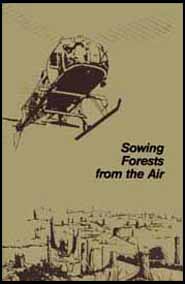Page Header
[ Enter you text here. ]
TOOLS REFORESTING THE TROPICS
Perhaps the most versatile and useful tree, giant leucaena is a tool for tropical reforestation. A godsend to poor families, it yields fire¬wood and fine animal feed. A boon to the environment, it rebuilds depleted soils and provides shade, shelter, and general beautif¬ication. Best of all, though, it grows fast enough to absorb possibly more CO2 per acre than any other tree. And its wood is of furniture grade, so that greenhouse gas gets locked away for generations.
When conditions are right, giant leucaena can surpass 8 feet a year. Specimens in the Philippines have topped 66 feet with 16-inch diameter trunks in just 8 years. Though the trunks are typically imperfect, the wood itself is hard, heavy and high quality. It also makes useful pulp and paper, and other products.
Leucaena: Promising Forage and Tree Crop for the Tropics (second edition) is a 93 page summary created in 1984 by a panel of experts convened by the National Academy of Sciences. Chapter titles include: Experiences with Leucaena, The Plant, Animal Feed, Wood Products, Soil Improvement and Reforestation, and Other Uses. Though somewhat overtaken by massive subsequent plantings, this is still a valuable overview of a powerful tool for making a better world.
$10.00, Buy Now
World's Best Global Cooler?
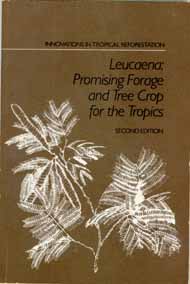
A stately tree, mangium (Acacia mangium) is a tropical legume that is gentle on the land and provides wood and other resources that deflect poor people from destroying natural forests.
More important, though, is grows with amazing speed: sometimes rising 10 feet a year. It could actually absorb notable amounts of the global CO2 surplus because it colonizes the red, acid, largely barren sites that dominate the deforested tropics. In particular it could reclaim millions of square miles now lost to imperata, a pernicious “cutting grass” that fosters wildfires and repels people and animals, not to mention other plants.
The economic benefits from restoring vast zones that today are worthless to people as well as nature would alone run into the billions. In addition, mangium helps native vegetation regenerate. This multipurpose tree thus acts as a natural nursemaid catalyzing the rainforests’ return to the barren hills and cooling the planet at the same time.
Mangium and Other Fast-Growing Acacias for the Humid Tropics highlights several related acacia species. This 63 page book, printed in 1983, fostered many mangium plantings in South East Asia. Though dated in some details, it remains a fine assessment of the tree and its promise.
$5.00, Buy Now
Rainforest Restorer
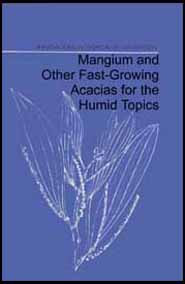
A small tree that soars 20 feet in 12 months, calliandra can there¬after be cut annually, providing firewood “forever.” Though its branches are barely bigger than broomsticks, they are easily cut with a machete, make good cooking fuel, and relieve women’s daily wood-gathering burdens.
This woody legume also allows “stationary slash-and-burn," in which people regenerate their own land over and over instead of continually cutting down more and more forest. Peasant farmers in eastern Indonesia perfected this sustainable farming rotation, which has immense significance for saving tropical rainforests by providing the surrounding citizens with the wood, the fertile soil for their food crops, and the forage for their animals.
Calliandra: A Versatile Small Tree for the Humid Tropics is a 56 page book that shows how Indonesian villagers and government agencies exploit this Latin American tree to provide firewood, forage, honey, and soil improvement, not to mention stabilizing steep slopes. Ideally suited to subsistence farming and infertile soils, calliandra has in recent decades become established in Southeast Asia as well as tropical Africa. Although written in 1983, the book is still a fine introduction to this remarkable tree that may look like a forester’s fright but is a farmer’s friend.
$5.00, Buy Now
The Year-by-Year Tree
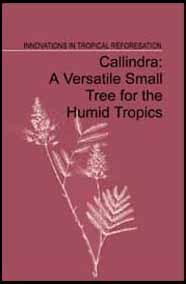
A dozen or so nitrogen-fixing Australasian trees promise to stabilize cruel, barren, eroding sites while providing various kinds of wood products. Collectively, they represent tools for resurrecting problem sites, where barrenness, drought and other harsh environmental conditions leave no other alternatives.
Casuarinas: Nitrogen-Fixing Trees for Adverse Sites highlights species that between them offer help to the toughest treeless locales in: 1) tropical lowlands, 2) tropical highlands, 3) temp¬erate zones, and 4) semiarid regions.
Published in 1984, this 125 page review drew international attention to this robust-tree genus whose inherent promise is poorly appreciated. Although several conferences and research projects resulted and research and planting trials are underway in California, Australia, Egypt, and elsewhere, this book nonetheless provides instructive insights into the practical promise of nature’s toughest tree genus.
$5.00, Buy Now
Nature's Toughest Tree
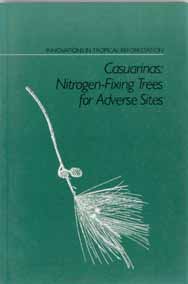
Possibly half the timber cut in the world still serves as fuel for cooking and heating. Each year more than a billion families burn as much as a ton of firewood. Human population growth, however, is far outpacing the production of trees. The result: soaring prices for wood, sinking incomes and a waste of women’s time and energy, not to mention the inexorable spread of treeless landscapes.
In an era when it seems as if every tree in the tropics will soon be burned up, leaving billions without fuel to make their food edible two books offer guidance and hope. These products of National Academy of Sciences studies expose a broad selection of species suitable for cultivation for fuel in developing countries:
Firewood Crops: Shrub and Tree Species for Energy Production, Volume 1 is a 237-page fully illustrated book describing 60 woody plants. Volume 2 is a 103-page sequel describing 27 more species likely to be good fuel producers for poor nations.
Trees that Cook the Food
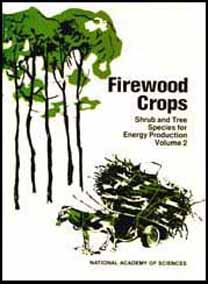
For a cooler planet we need more tree cover—massive more tree cover. And we need it fast. One likely location is the vast deforested backcountry in Africa, Asia and Latin America. One way to rapidly restore a tree cover is by spraying tree seed from aircraft. makes no sense. Not, that is, until you realize that trees need to be seeded when crops are seeded . . . a time when the rural workforce is otherwise occupied.
Sowing Forests from the Air
$5.00, Buy Now
Creating Forests Fast
